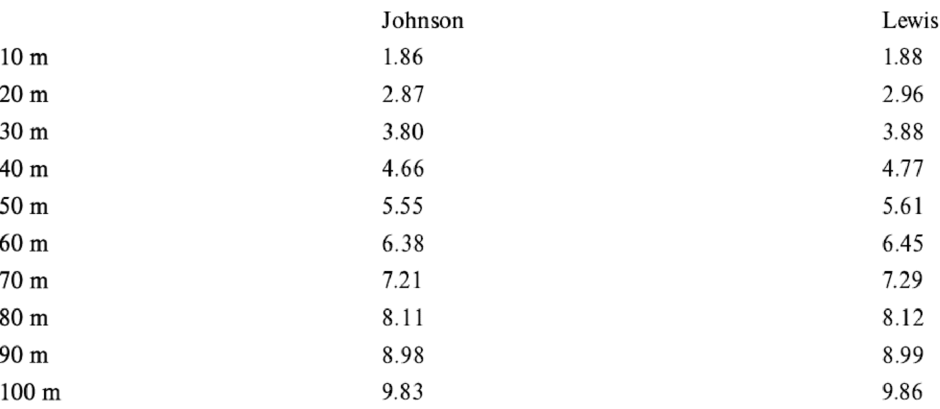
BASIC BIOMECHANICS
8th Edition
ISBN: 9781259913877
Author: Hall
Publisher: RENT MCG
expand_more
expand_more
format_list_bulleted
Concept explainers
Textbook Question
Chapter 10, Problem 1AP
Answer the following questions pertaining to the split times (in seconds) presented below for Ben Johnson and Carl Lewis during the 100-m sprint in the 1988 Olympic Games.

a. Plot velocity and acceleration curves for both sprinters. In what ways are the curves similar and different?
b. What general conclusions can you draw about performance in elite sprinters?
Expert Solution & Answer
Trending nowThis is a popular solution!

Chapter 10 Solutions
BASIC BIOMECHANICS
Ch. 10 - A runner completes 6 laps around a 400 m track...Ch. 10 - A ball rolls with an acceleration of 0.5 m/s2. If...Ch. 10 - A wheelchair marathoner has a speed of 5 m/s after...Ch. 10 - An orienteer runs 400 m directly east and then 500...Ch. 10 - An orienteer runs north at 5 m/s for 120 s and...Ch. 10 - Why are the horizontal and vertical components of...Ch. 10 - A soccer ball is kicked with an initial horizontal...Ch. 10 - If a baseball, a basketball, and a 71.2-N shot...Ch. 10 - A tennis ball leaves a racket during the execution...Ch. 10 - Prob. 10IP
Ch. 10 - Answer the following questions pertaining to the...Ch. 10 - Provide a trigonometric solution for Introductory...Ch. 10 - Provide a trigonometric solution for Introductory...Ch. 10 - A buoy marking the turn in the ocean swim leg of a...Ch. 10 - A sailboat is being propelled westerly by the wind...Ch. 10 - A Dallas Cowboy carrying the ball straight down...Ch. 10 - A soccer ball is kicked from the playing field at...Ch. 10 - A ball is kicked a horizontal distance of 45.8 m....Ch. 10 - A badminton shuttlecock is struck by a racket at a...Ch. 10 - An archery arrow is shot with a speed of 45 m/s at...
Knowledge Booster
Learn more about
Need a deep-dive on the concept behind this application? Look no further. Learn more about this topic, bioengineering and related others by exploring similar questions and additional content below.Similar questions
Recommended textbooks for you
 Human Physiology: From Cells to Systems (MindTap ...BiologyISBN:9781285866932Author:Lauralee SherwoodPublisher:Cengage LearningLifetime Physical Fitness & WellnessHealth & NutritionISBN:9781337677509Author:HOEGERPublisher:Cengage
Human Physiology: From Cells to Systems (MindTap ...BiologyISBN:9781285866932Author:Lauralee SherwoodPublisher:Cengage LearningLifetime Physical Fitness & WellnessHealth & NutritionISBN:9781337677509Author:HOEGERPublisher:Cengage Principles Of Radiographic Imaging: An Art And A ...Health & NutritionISBN:9781337711067Author:Richard R. Carlton, Arlene M. Adler, Vesna BalacPublisher:Cengage Learning
Principles Of Radiographic Imaging: An Art And A ...Health & NutritionISBN:9781337711067Author:Richard R. Carlton, Arlene M. Adler, Vesna BalacPublisher:Cengage Learning

Human Physiology: From Cells to Systems (MindTap ...
Biology
ISBN:9781285866932
Author:Lauralee Sherwood
Publisher:Cengage Learning


Lifetime Physical Fitness & Wellness
Health & Nutrition
ISBN:9781337677509
Author:HOEGER
Publisher:Cengage


Principles Of Radiographic Imaging: An Art And A ...
Health & Nutrition
ISBN:9781337711067
Author:Richard R. Carlton, Arlene M. Adler, Vesna Balac
Publisher:Cengage Learning

GCSE PE - ANTAGONISTIC MUSCLE ACTION - Anatomy and Physiology (Skeletal and Muscular System - 1.5); Author: igpe_complete;https://www.youtube.com/watch?v=6hm_9jQRoO4;License: Standard Youtube License